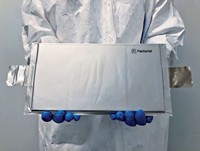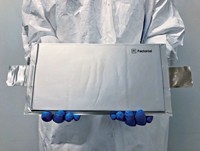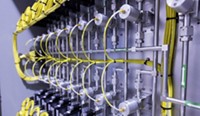Advertisement
Grab your lab coat. Let's get started
Welcome!
Welcome!
Create an account below to get 6 C&EN articles per month, receive newsletters and more - all free.
It seems this is your first time logging in online. Please enter the following information to continue.
As an ACS member you automatically get access to this site. All we need is few more details to create your reading experience.
Not you? Sign in with a different account.
Not you? Sign in with a different account.
ERROR 1
ERROR 1
ERROR 2
ERROR 2
ERROR 2
ERROR 2
ERROR 2
Password and Confirm password must match.
If you have an ACS member number, please enter it here so we can link this account to your membership. (optional)
ERROR 2
ACS values your privacy. By submitting your information, you are gaining access to C&EN and subscribing to our weekly newsletter. We use the information you provide to make your reading experience better, and we will never sell your data to third party members.
Energy
Lithium-Sulfur Battery Boost
Sasol’s $24 million investment sets up Oxis Energy for commercialization of its lithium-sulfur technology
by Alex Scott
October 22, 2012
| A version of this story appeared in
Volume 90, Issue 43

“That’s one of ours,” says Mark Crittenden, customer brand manager for Oxis Energy, pointing proudly to a metal box attached to one of several prototype electric bikes in the firm’s reception area. Crittenden doesn’t stop to show off the lithium-sulfur battery inside the box. Like his coworkers in Abingdon, England, he’s in a hurry to move on. A recent investment by the South African oil and chemicals giant Sasol means Oxis’ status has changed from a start-up surviving on interim R&D funding to a firm with sufficient cash to commercialize its technology.
But if Oxis is to succeed in supplying its technology to the electric-car market, its batteries will have to compete on performance and price against established lithium-ion batteries. Oxis also faces competition from Sion Power, a Li-S battery start-up firm in which BASF invested $50 million earlier this year.
“Until now, it has all been about getting the technology up to the mark, including specific energy, safety, and lightness of weight,” says Chief Financial Officer Chris Murray. He expects the firm will have a Li-S battery on the market in 2014 or 2015.
Sasol is providing Oxis with $24 million in cash plus capability and experience in process scale-up and commercial manufacturing. In return, Sasol has secured an undisclosed minority stake in Oxis. “There could be some interesting synergies between the companies,” Murray says. Oxis has a staff of 40. With Sasol’s funding in place, the firm expects staff numbers to hit 80 in 2015.
Traditional Li-ion batteries feature a carbon cathode, a lithium oxide anode, and an electrolyte containing lithium salts. Oxis’ Li-S battery, in contrast, features a sulfur-based cathode, a lithium metal anode, and a lithium sulfide electrolyte. The firm claims that the battery can outcompete Li-ion batteries on a variety of important performance parameters.
Oxis says it avoids the explosion risk of using lithium metal with its lithium sulfide electrolyte, which instantaneously forms a film on the metal. With a melting point of 938 °C, this coating protects the lithium even at extreme temperatures. A high flashpoint for the electrolyte further ensures battery safety, Crittenden says.
The firm claims to have a strong technology position, particularly in battery cell architecture, with 27 patents in the field of Li-S batteries and 31 patents pending.
Oxis has a team of eight scientists. Additionally, the firm collaborates with the Ufa Scientific Center at the Russian Academy of Sciences in Ufa, Russia. Vladimir Kolosnitsyn, Oxis’ chief technology officer and the author of 16 of the firm’s patents, developed the connection with the Russian academy.
Among their advantages, Li-S batteries have a theoretical specific energy capacity of 2,700 watt-hours per kilogram, five times that of Li-ion batteries, the material of choice for today’s hybrid electric-gasoline cars, Oxis says.
The latest version of Oxis’ Li-S battery has a specific energy capacity of 320 Wh/kg, but the firm has ambitions to increase that. “We’d like to see 410 Wh/kg by the end of 2014,” Murray says. Most Li-ion batteries on the market today have a specific energy capacity of 100–200 Wh/kg. An example is the one in Nissan’s Leaf electric car, which has a specific energy capacity of about 120 Wh/kg.
Oxis says the weight of its battery is half that of a Li-ion battery with the same performance. With Li-ion batteries for cars weighing hundreds of pounds, Oxis claims that its lighter Li-S battery could increase the distance that a battery-powered car can travel by 30%.
As well as being relatively light, Oxis’ Li-S battery is “able to recharge and discharge 100% of its energy over multiple cycles,” Crittenden says. In contrast, “a Li-ion battery is typically only used over 80% of its capacity to avoid damaging the capacity in future cycles,” Murray adds.
A substantial part of Oxis’ research focuses on developing the Li-S battery’s cycle life. The battery is now stable for up to 350 cycles, with 1,000 cycles targeted by 2014. A 2009 study of Li-ion batteries at Pennsylvania State University showed that after 5,250 cycles and “under typical hybrid-electric vehicle conditions,” peak energy capacity was reduced by 18%.
Improvements in the cycle life of Oxis’ battery are anticipated to come from further modifications to the battery cell architecture and development of new materials, in particular polymer binders, carbon materials, electrode substrates, and electrolyte. The company is now in discussions with chemical companies to supply such materials, Murray says.
Oxis can’t claim the Li-S battery with the highest specific energy, however. That record is held by Tucson-based Sion, a spin-off from Brookhaven National Laboratories. Sion has a Li-S battery with a specific energy capacity above 350 Wh/kg.
BASF, which has been building a portfolio of battery technologies, acquired a stake in Sion in January in exchange for its $50 million investment in the firm. Sion has yet to disclose when it will roll out its technology but states that it “is very optimistic that the future of all electric-vehicle applications will be dominated” by its Li-S technology.
Although Li-S batteries have some performance advantages over Li-ion batteries, their market success is not ensured. “I am not sure I would say that Li-S will be the natural successor to Li-ion,” says Jerry Barker, chief technology officer at Faradion, an England-based non-lithium-battery technology start-up and a serial inventor of battery technologies, including the world’s first fluorophosphate-based Li-ion battery.
Li-ion cells are likely to be the dominant battery technology for the next 10 years, Barker says. Improvements in Li-ion chemistries and production processes will bring costs down from between $750 to $1,000 per kWh, to perhaps less than $500 per kWh, he predicts. Oxis says it expects its Li-S product to be able to compete on price.
Li-S “certainly promises a much higher energy density than current Li-ion cells, but there are a number of technical challenges to overcome—namely safety, cycle life, calendar life, and self-discharge,” Barker says. “It’s not easy.”
Oxis is convinced it has overcome the key technological challenges and is pressing ahead with plans to license its Li-S technology to battery manufacturers. “In the past nine months we’ve been engaging with the world’s leading battery manufacturers. We hope to have an official collaboration in place in the fourth quarter of this year,” Crittenden says.
The company’s Li-S cells are already being tested in prototype vehicles by firms including QWIC Hartmobile, which is developing electric scooters in the Netherlands; Norwegian firm Engbo for electric boats; and French firm Induct for its Modulgo urban car. QWIC plans to launch an electric scooter powered by Oxis’ Li-S battery in 2014.
Oxis’ ultimate goal is to carve out a leading position for Li-S in the electric-car market. Although the company has yet to secure a deal with a major automotive company, it anticipates that its entry into Europe’s electric-scooter market will quietly and efficiently show auto companies how well its Li-S battery can perform.





Join the conversation
Contact the reporter
Submit a Letter to the Editor for publication
Engage with us on Twitter